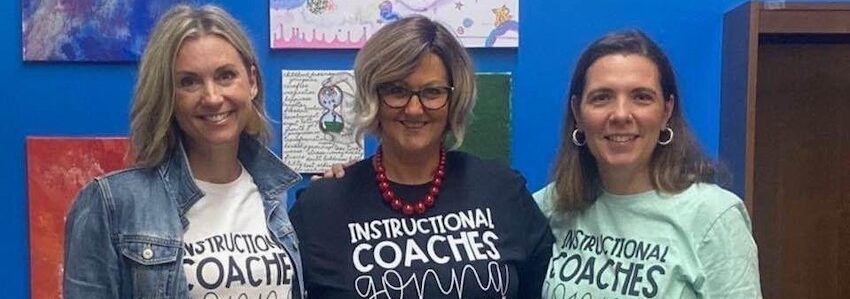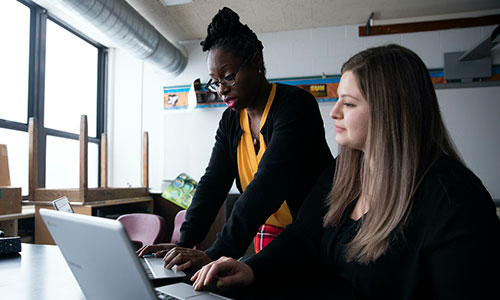
In a conference room in Columbus City, Ohio, a team of three instructional coach leads—Karen Fiedler, Jen Erickson, and Roni Becht—engage in a team-building activity involving a unique deck of cards. This activity aims to help the coaches identify their core values and motivators. As they intentionally listen to each other’s card results, laughter fills the room: their results are strikingly similar. This strong alignment of core values comes as no surprise considering the success they have collectively achieved in building an effective instructional coaching program over the course of three and a half years.
Over the past decade, instructional coaching positions have been established in numerous districts with varying levels of success. Columbus is an urban capital city, and Columbus City Schools serves a diverse student population of nearly 46,000 students across 117 schools. Despite facing significant challenges, such as a post-pandemic budget shortfall, a teachers’ labor union strike, and a change in superintendent, the instructional coaching program has remained a constant source of professional learning and capacity building for the school-based coaches and teachers they support.
What has set the Columbus City instructional coaching program apart? How have they achieved multiyear success and managed to retain instructional coaches at a rate of greater than 80% (a role that often experiences extremely low retention rates in other geographies)? The coach leads from Columbus City recently shared their advice, wisdom, and lessons learned with me.
As designated point people for instructional coaching in their district, the Columbus City leads serve as ongoing professional development facilitators, communicators, and trusted advisors to other instructional coaches. They also coordinate and manage the planning and alignment of their district’s instructional initiatives, mission, and vision. Coach leaders can be administrators, but in many systems that is not necessary or appropriate. In either case, their role should be clearly defined with sufficient time and resources to develop an effective instructional coaching program.
1. Understand priorities
To influence the larger system effectively, coach leaders must work together to gain a clear understanding of the priorities and goals of district leaders. When designing professional learning and setting coaching goals, it is essential to ensure that the objectives align with a district’s priorities. Regular retreats and planning sessions should be scheduled to analyze coaching program data, goals, and alignment with the district’s initiatives.
Columbus City coach lead Jen describes how her team continually worked together to align the role of school-based instructional coaches with the bigger picture of the district’s long-range goals for coaching. In addition to providing opportunities for whole-group professional learning with the school-based coaches, the leads carved out regular time to meet virtually and in person. “We built in protected time for our core team to synthesize and design what the needs and outcomes would be,” she explains.
Research supports the importance of aligning coaching goals with district priorities. For an instructional coaching program to become successful, it cannot live in isolation and, instead, must align with the overall goals of the school or district. By understanding and incorporating the priorities of district leaders, coach leaders can ensure that the instructional coaching program is well-aligned and focused on achieving the desired outcomes.
“First and foremost, you must decide what you want the outcome of the coaching to be because the term ‘coach’ is extremely expansive and used interchangeably to describe various roles in schools,” Roni advises. “Once you understand the priorities and goals of hiring coaches, you can build your coaching model to satisfy that purpose.”
In Columbus City, the lead team formally defined the role of the coach at the internal level so that principals had more clarity on how coaches should support teachers in their learning needs.
2. Consult experts
As the Columbus City coach leads strategically worked to build the capacity of the instructional coaches they served, they also knew they needed their own unique professional development in coach leadership. To complement the in-house professional learning and on-site support, they also sought outside expertise from Jim Knight’s Instructional Coaching Group and NWEA, among others. This robust approach ensured that coaches at all levels of experience could receive differentiated, experiential learning as they formed a district-wide culture of coaching.
Roni describes the value of ongoing, sustained professional learning for coach leads: “For me, it’s been crucial to reflect on our team success and connect what the team is working toward.” Karen agrees: “Even when times are challenging, I leave inspired and ready to incorporate new ideas into coaching conversations.”
Upon reflecting on how consulting an external expert supports her own coaching practice, Jen explains that “Working with our own coach helps me unpack current dilemmas and, in turn, my approach to coaching focuses on hope.”
3. Build relationships
While building relationships with teachers is important, instructional coaches also need to work alongside school and district leaders. Establishing positive relationships with key decision-makers allows for effective communication of the barriers and successes of coaching. Coach leaders should seek opportunities to engage with leaders by attending district events or inviting them to witness coaching in action.
To establish and maintain trusting relationships across their district, the Columbus City coach leads strategically delegate responsibilities based on their individual strengths, and they offer a variety of methods for school-based coaches to get support. This includes monthly in-person workshops focused on coaching skills and knowledge, site-based visits for one-to-one coaching, and virtual office hours. “It’s not always perfect, but our teamwork strives to be productive, innovative, and creative,” says Roni on their approach to supporting coaches.
As the focus of their coaching model has always been building capacity across the district, they share a story of observing a veteran coach reaching out to support a new coach. Research conducted by Andy Hargreaves and Michael Fullan emphasizes the importance of relationships in leadership. They argue that effective leaders build strong relationships with colleagues and stakeholders, which in turn leads to greater support and collaboration.
By forging relationships with district leaders, coach leaders can gain their trust and support, enabling them to influence the larger system effectively. The Columbus City coach leads developed a system to strategically communicate important coaching updates and stories of coaching success with administrators to offer as much transparency as possible.
4. Embody a “way of being”
In Columbus City, the coaching framework includes a “way of being” component for all coaches to draw from in their daily coaching conversations with teachers. At its core, this looks like withholding judgment, seeking to understand, building emotional connections, redirecting destructive conversations, and building trust by treating others as equal collaborators. Roni states, “The power in having a ‘way of being’ means you don’t talk about it. You just do it.”
Coach leads have offered on-site workshops to develop a collaborative vision for their “way of being” as well as offer opportunities for coaches to engage in roleplay and peer coaching to practice their “way of being.” They have also drawn inspiration and guidance from coaching experts, such as Elena Aguilar’s Bright Morning team and the NWEA instructional coaching team.
In conclusion
The work of Columbus City Schools instructional coach leads—Karen, Jen, and Roni—demonstrates how the role of a coach lead can bridge the gap between the day-to-day work of instructional coaches and the priorities of district and instructional leaders, ultimately leading to improved student learning outcomes. In Columbus City, where there have been many competing initiatives over the years, the coach leads remain focused on the primary outcomes of coaching by continually reflecting and planning for the bigger picture. “You have to stay the course,” Karen says. “All these other initiatives are coming at you and will impact the way you are designing your program. You have to continually be asking, ‘Does this further the purpose of the outcome coaching model?’”
By establishing clear connections between coaching objectives and district priorities, consulting experts, cultivating relationships with decision-makers, and embodying an authentic culture of coaching in daily practice, coach leaders can influence the larger system and ensure support and sustainability for an instructional coaching program.







